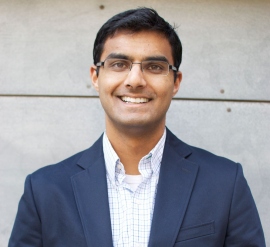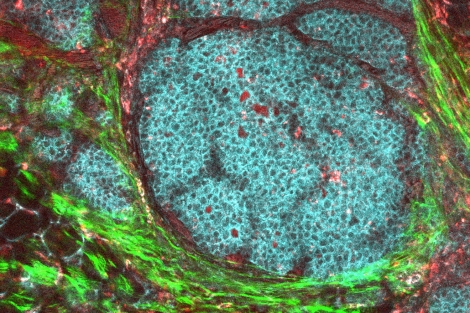Optimizing Drugs Based on Tumor Genetics
Chemotherapies are potent toxins delivered into the bloodstream to kill tumor cells throughout the body by damaging DNA in rapidly dividing cells. However, these poisons can also do significant harm to other dividing cells such as those found in the stomach lining and in hair and nail follicles, as well as the blood and immune stem cells in the bone marrow. In addition, cancer cells’ susceptibility to these agents varies widely, and tumors often develop resistance to drugs that initially seem effective.There are more than 100 chemotherapy agents in wide use, but oncologists have very little information to guide their decisions about which of these drugs to use in a given patient. These decisions are typically guided by the drugs’ average historical success rate for different types of cancer, rather than any understanding of how the chemotherapy drug will interact with the genetic profile of a specific tumor.
“We know very little about how gene mutations in tumor cells can change how a tumor might respond or not to certain chemotherapy drugs. Mapping these sorts of connections could make it possible to optimize which drugs patients get based on their tumor genetics,” said Bandyopadhyay, a member of the UCSF Helen Diller Family Comprehensive Cancer Center and the Quantitative Biosciences Institute.
Now — in a paper published online April 17, 2018 in Cell Reports — Bandyopadhyay’s lab has systematically mapped connections between 625 breast and ovarian cancer genes and nearly every FDA-approved chemotherapy for breast or ovarian cancer. Led by Hsien-Ming “Kevin” Hu, PhD, Bandyopadhyay’s group developed a high-throughput combinatorial approach that allowed them to perform 80,000 experiments in laboratory dishes in a matter of weeks. The authors said their results, which they have made publicly available, constitute an invaluable resource to help clinicians predict which chemotherapies will be most effective against tumor cells with particular genetic mutations, and how to rationally combine therapies to prevent cancers from developing resistance.

Predicting Response to Chemotherapy
The team began by identifying hundreds of genes frequently mutated in human cancers: 200 implicated in breast cancer, 170 linked to ovarian cancer, and 134 involved in DNA repair, which is compromised in many types of cancer. They then mimicked the effects of such mutations in lab dishes by systematically inactivating each of these cancer-associated genes in healthy human cells, creating 625 different perturbations that mirrored distinct genetic mutations seen in real breast and ovarian cancers.The researchers then exposed cells from each of these lines to a panel of 31 different drug treatments — including 23 chemotherapy compounds approved by the FDA for breast and ovarian cancers, six targeted cancer drugs, and two common drug combinations. An automated microscopy system monitored the cells’ health and recorded which groups of cells were killed, which survived, and which developed resistance when exposed to a particular treatment.
The resulting “map” of gene-drug interactions allowed the researchers to accurately predict the responses of multiple human cancer cell lines to different chemotherapy agents based on the cell lines’ genetic profiles and also revealed new genetic factors that appear to determine the response of breast and ovarian tumor cells to common classes of chemotherapy treatment.
Clinical Trial for Ovarian Cancer
As a proof of principle, the researchers collaborated with Clovis Oncology, a biotech company based in Boulder, Colorado, which is running a clinical trial of drugs known as PARP inhibitors in patients with stage II ovarian cancer. Based on their gene–drug interaction map, the researchers predicted that mutations in two genes, called ARID1A and GPBP1, could contribute to ovarian cancer’s ability to develop resistance to this class of drugs. Results from the clinical trial bore out these predictions: patients with these mutations were significantly more likely to develop resistance.Bandyopadhyay’s team has deposited the trove of data generated in the new study in a database maintained by the National Cancer Institute so that other researchers can mine it for information about drug combinations and derive new biological insights about the basis for chemotherapy’s success or failure. The lab is also working with the Breast Oncology Program at UCSF to make this data part of an adaptive clinical trial called I-SPY, which lets researchers identify the most effective therapies based on patient molecular profiling, and is collaborating with members of the UCSF Institute for Computational Health Sciences (ICHS) to put these and other public data into a centralized database that clinicians can access through an app to help make the most appropriate treatment decisions.
In the future, Bandyopadhyay says, better understanding how chemotherapy agents impact specific biological pathways should allow drug trials to focus on patients who are more likely to respond to the drugs being tested and enable clinicians to identify targeted or combination therapies for patients with a genetic predisposition to resistance.
Other authors on the study included Xin Zhao, PhD, Swati Kaushik, PhD, Antoine Barthelet, Kevin K. Lin, PhD, and Khyati N. Shah, PhD, of UCSF; and Lilliane Robillard, PhD, Andy D. Simmons, PhD, Mitch Raponi, PhD, and Thomas C. Harding, PhD, of Clovis Oncology.
The study was funded by the NCI (U01CA168370), the UCSF Program in Breakthrough Biomedical Research (PBBR) and the UCSF Breast Oncology SPORE development award.
Conflict of Interest Statement: Co-authors Robillard, Simmons, Raponi, and Harding are employees of Clovis Oncology.
